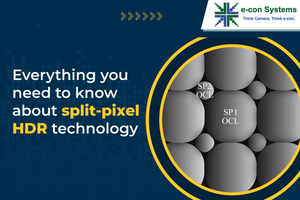How does the split-pixel HDR technique work?
Featured Product from e-con Systems™ Inc

Split-pixel HDR (High Dynamic Range) technology holds significant importance in the realm of embedded vision as it enables camera systems to capture and reproduce a wider range of brightness levels. It is also known as sub-pixel HDR technology as it involves splitting each pixel on the sensor into two sub-pixels to capture the brighter and darker areas of the scene. Since the camera system simultaneously captures images – not sequentially, this results in reduced motion blur and delivers more vibrant and true-to-life images. Basically, it provides a more accurate representation of colors – thereby delivering images that closely resemble the natural color tones of the scene.
Some of the popular use cases of split-pixel HDR include automotive imaging for ADAS and autonomous vehicles, medical imaging for accurate diagnostics, and more.
In this blog, let’s look at the different HDR modes, find out how split-pixel HDR works, and get insights into why this technology is gaining prominence. Read More >>










